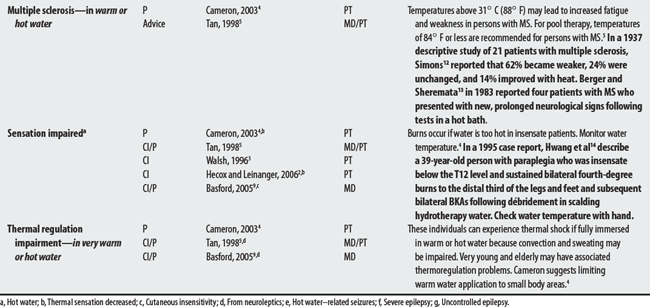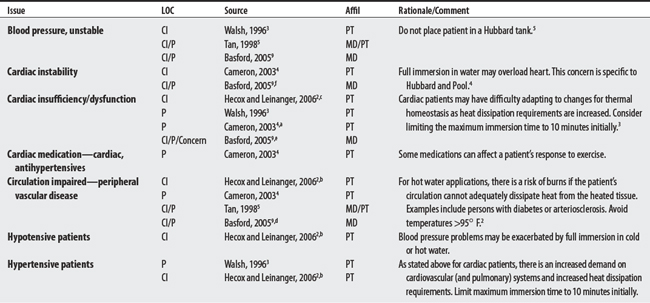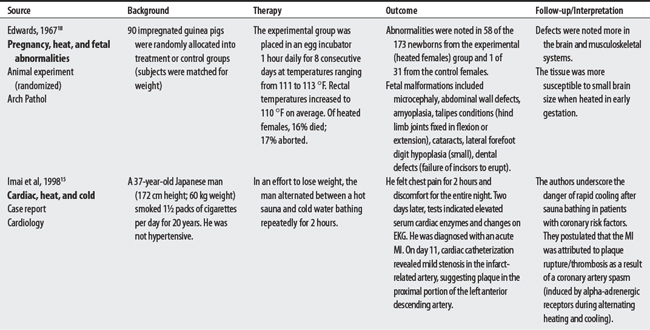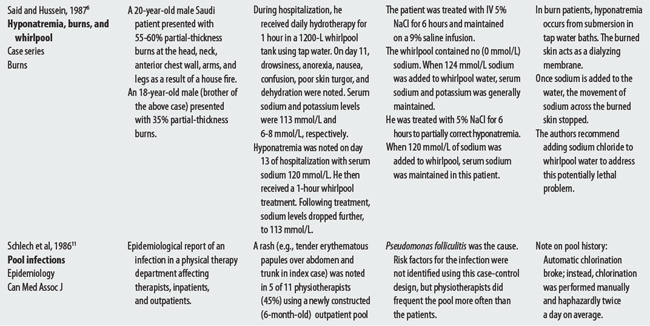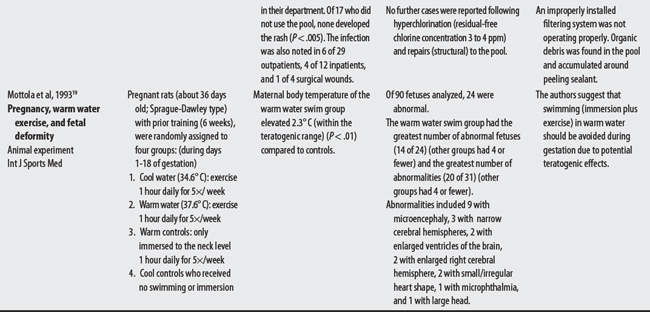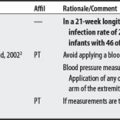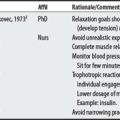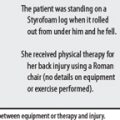Chapter 44 Hydrotherapy
INCLUDES FULL BODY IMMERSION; WHIRLPOOL EXCLUDES DEBRIDEMENT/WOUND CARE (SEE DEBRIDEMENT) EXCLUDES AQUATIC THERAPY (SEE AQUATIC THERAPY)
OVERVIEW.
Hydrotherapy is water treatment used for exercises, pain management, and wound care1 and includes whirlpool, pool therapy, and contrast baths. Hydrotherapy benefits are derived from its cleansing action, buoyancy properties (reduced weight bearing), hydrostatic pressure effects (improved venous return), and psychological effects.
Sources generally recommend monitoring patient vital signs (because of patients’ inability to lose heat while in water if fully immersed), check temperature levels, clean tanks, and caution to never leave patient unattended during or after hydrotherapy.2,3 Note: (1) Because of the potential for cross-contamination, aspiration, drowning, cardiovascular stress, and burns (in heated water), patient screening is required. (2) If hydrotherapy is used in conjunction with hot or cold water, then superficial heat and cryotherapy concerns also apply, respectively.3–5
OTHER ISSUES: ELECTROLYTE IMBALANCES IN BURNS, SLIPS, AND FALLS, AND HAIR ENTANGLEMENT.
(1) Said and Hussein,6 in a 1987 case series, reported on two brothers who sustained partial-thickness burns and subsequently developed hyponatremia while immersed in a whirlpool filled with tap water. (2) In a 1994 Missouri lawsuit,7 a man with arthritis was awarded $47,773.90 after he slipped and fractured his patella while being assisted out of a whirlpool bath. (3) The CPSC8 reported 43 incidences of hair getting sucked into suction fittings of spas, whirlpools, or hot tubs, including 12 deaths (the head of victim was trapped underwater).
CONTRAINDICATIONS AND PRECAUTIONS FOR HYDROTHERAPY
A00-B99 CERTAIN INFECTIONS AND PARASITIC DISEASES
D50-D89 DISEASES OF BLOOD AND BLOOD-FORMING ORGANS AND CERTAIN DISORDERS
F00-F99 MENTAL AND BEHAVIORAL DISORDERS
G00-G99 DISEASES OF THE NERVOUS SYSTEM
I00-I99 DISEASES OF THE CIRCULATORY SYSTEM
J00-J99 DISEASES OF THE RESPIRATORY SYSTEM
K00-K93 DISEASES OF THE DIGESTIVE SYSTEM
L00-L99 DISEASES OF THE SKIN AND SUBCUTANEOUS TISSUE
M00-M99 DISEASES OF THE MUSCULOSKELETAL SYSTEM AND CONNECTIVE TISSUE
N00-N99 DISEASES OF THE GENITOURINARY SYSTEM
O00-O99 PREGNANCY, CHILDBIRTH, AND PUERPERIUM
R00-R99 SYMPTOMS, SIGNS, AND ABNORMAL CLINICAL AND LABORATORY FINDINGS (NOT ELSEWHERE CLASSIFIED)
S00-T98 INJURY, POISONING, AND CERTAIN OTHER CONSEQUENCES OF EXTERNAL CAUSES
ADVERSE EVENTS
U.S. CONSUMER PRODUCT SAFETY COMMISSION8
| Event | Background | Recommendations |
|---|---|---|
| Body part entrapment | Since 1990, 74 incidences (with 2 disembowelments and 13 deaths) occurred whereby the body was entrapped by strong drain suction in pools, wading pools, spas, and hot tubs. | CPSC standards require down-shaped drain outlets and 2 outlets of each pump to reduce suction power if one drain becomes blocked. Warn of drain covers in spas, hot tubs, and whirlpools resulting in hair entanglement and body part entrapment. |
| Child drownings | CPSC reports move than 800 deaths in spas and hot tubs since 1990 (a fifth were in children under age 5) | There is a need for locked safety covers or constant adult supervision. |
| Hair entanglement | There have been 43 incidences with 12 deaths. Children play “hold your breath the longest.” | This occurs when hair became entangled in drain covers. Get drain covers that meet CPSC standards. Warn of drain covers in spas, hot tubs, and whirlpools resulting in hair entanglement and body part entrapment. |
| Hair gets sucked into suction fittings in the spa, hot tub, or whirlpool resulting in the head being held under water. | ||
| Hot tub temperatures | CPSC reports several cases of extremely hot water (about 110°F) that led to drowsiness and unconsciousness and then drowning. High temperatures can also raise body temperature and lead to heat stroke and death. | Spa water temperatures should never exceed 104°F. |
| Pregnant women and young children should consult with their physicians. |
1 Eisenberg MG. Dictionary of rehabilitation. New York: Springer, 1995.
2 Hecox B, Leinanger PM. Hydrotherapy. In: Hecox B, Mehreteab TA, Weisberg J, editors. Integrating physical agents in rehabilitation. Upper Saddle River (NJ): Pearson Prentice Hall, 2006.
3 Walsh MT. Hydrotherapy: the use of water as a therapeutic agent. In Michlovitz SL, editor: Thermal agents in rehabilitation, ed 3, Philadelphia: F.A. Davis, 1996.
4 Cameron MH. Physical agents in rehabilitation: from research to practice. St. Louis: Saunders, 2003.
5 Tan JC. Practical manual of physical medicine and rehabilitation: diagnostics, therapeutics, and basic problems. St. Louis: Mosby, 1998.
6 Said RA, Hussein MM. Severe hyponatraemia in burn patients secondary to hydrotherapy. Burns. 1987;13(4):327-329.
7 Medical malpractice verdicts, settlements and experts, Dec 1994, p 45 loc 4.
8 Consumer Product Safety Commission. Spas, hot tubs, and whirlpools. Available at: http://www.cpsc.gov/cpscpub/pubs/5112.pdf. Accessed November 26, 2005
9 Basford JR. Therapeutic physical agents. Delisa JA, editor. Physical medicine and rehabilitation: principles and practices, ed 4, vol 1. Philadelphia: Lippincott Williams & Wilkins, 2005.
10 McGuckin MB, Thorpe RJ, Abrutyn E. Hydrotherapy: An outbreak of Pseudomonas aeruginosa wound infections related to Hubbard tack treatments. Arch Phys Med Rehab. 1981;62:283-285.
11 Schlech III, Simonsen N, Sumarah R, et al. Nosocomial outbreak of Pseudomonas aeruginosa folliculitis associated with a physiotherapy pool. Can Med Assoc J. 1986;134:909-913.
12 Simons DJ. A note on the effect of heat and of cold upon certain symptoms of multiple sclerosis. Bull Neurol Inst N Y. 1937;6:385-386.
13 Berger JR, Sheremata WA. Persistent neurological deficit precipitated by hot bath test in multiple sclerosis. JAMA. 1983;249(13):1751-1753.
14 Hwang JCF, Himel HN, Edlich RF. Bilateral amputation following hydrotherapy tank burns in a paraplegic patient. Burns. 1995;21(1):70-71.
15 Imai Y, Nobuoka S, Sagashima J, et al. Acute myocardial infarction induced by alternating exposure to heat in a sauna and rapid cooling in cold water. Cardiology. 1998;90(4):299-301.
16 Dorland’s illustrated medical dictionary. ed 24. Philadelphia: Saunders; 1965.
17 Milunsky A, Ulcickas M, Rothman KJ, et al. Maternal heat exposure and neural tube defects. JAMA. 1992;268(7):882-885.
18 Edwards MJ. Congenital defects in Guinea pigs following induced hyperthermia during gestation. Arch Pathol. 1967;84:42-48.
19 Mottola MF, Fitzgerald HM, Wilson NC, et al. Effect of water temperature on exercise-induced maternal hyperthermia on fetal development in rats. Int J Sports Med. 1993;14(5):248-251.
20 Magness JL, Garrett TR, Erickson DJ. Swelling of the upper extremity during whirlpool baths. Arch Phys Med Rehab. 1970;51(5):297-299.
21 Arledge RL. Prevention of electric shock hazards in physical therapy. Phys Ther. 1978;58(10):1215-1217.








